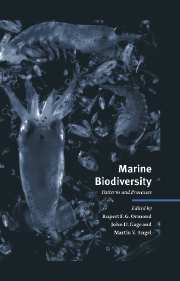Book contents
- Frontmatter
- Contents
- List of contributors
- Foreword: The value of diversity
- 1 Marine biodiversity in its global context
- 2 Gradients in marine biodiversity
- 3 Pelagic biodiversity
- 4 Biological diversity in oceanic macrozooplankton: More than counting species
- 5 Large-scale patterns of species diversity in the deep-sea benthos
- 6 Diversity, latitude and time: Patterns in the shallow sea
- 7 High benthic species diversity in deep-sea sediments: The importance of hydrodynamics
- 8 Diversity and structure of tropical Indo-Pacific benthic communities: Relation to regimes of nutrient input
- 9 Why are coral reef communities so diverse?
- 10 The biodiversity of coral reef fishes
- 11 The historical component of marine taxonomic diversity gradients
- 12 Population genetics and demography of marine species
- 13 Discovering unrecognised diversity among marine molluscs
- 14 Ecosystem function at low biodiversity – the Baltic example
- 15 Land–seascape diversity of the USA East Coast coastal zone with particular reference to estuaries
- 16 The development of mariculture and its implications for biodiversity
- 17 Protecting marine biodiversity and integrated coastal zone management
- 18 Conserving biodiversity in North-East Atlantic marine ecosystems
- Author index
- Species index
- Subject index
14 - Ecosystem function at low biodiversity – the Baltic example
Published online by Cambridge University Press: 04 August 2010
- Frontmatter
- Contents
- List of contributors
- Foreword: The value of diversity
- 1 Marine biodiversity in its global context
- 2 Gradients in marine biodiversity
- 3 Pelagic biodiversity
- 4 Biological diversity in oceanic macrozooplankton: More than counting species
- 5 Large-scale patterns of species diversity in the deep-sea benthos
- 6 Diversity, latitude and time: Patterns in the shallow sea
- 7 High benthic species diversity in deep-sea sediments: The importance of hydrodynamics
- 8 Diversity and structure of tropical Indo-Pacific benthic communities: Relation to regimes of nutrient input
- 9 Why are coral reef communities so diverse?
- 10 The biodiversity of coral reef fishes
- 11 The historical component of marine taxonomic diversity gradients
- 12 Population genetics and demography of marine species
- 13 Discovering unrecognised diversity among marine molluscs
- 14 Ecosystem function at low biodiversity – the Baltic example
- 15 Land–seascape diversity of the USA East Coast coastal zone with particular reference to estuaries
- 16 The development of mariculture and its implications for biodiversity
- 17 Protecting marine biodiversity and integrated coastal zone management
- 18 Conserving biodiversity in North-East Atlantic marine ecosystems
- Author index
- Species index
- Subject index
Summary
Abstract
For a marine area, the Baltic Sea has a uniquely low species diversity, due to its low salinity, recent geological origin and harsh climate. Its flora and fauna consist of a mixture of marine, freshwater and brackish-water species. The three major basins of the Baltic Sea, from south to north, have quite stable surface salinities of 6–8 psu in the Baltic proper, 5–6 psu in the Bothnian Sea and 2–4 psu in the Bothnian Bay.
A comparison of Steele's (1974) carbon flow model of the high diversity North Sea ecosystem, with Elmgren's (1984) carbon flow calculations for the Baltic Sea shows great similarity for the Baltic proper, and similar, but proportionally reduced, flows in the Bothnian Sea. Only the Bothnian Bay has a markedly different carbon flow pattern, due to a near-total absence of benthic filter-feeders. Only when a major functional group was lost, was there a drastic alteration of ecosystem function. The Baltic example suggests we should not claim without good proof that high biodiversity is needed to ‘maintain ecosystem function’.
The possibility remains that low diversity may destabilise ecosystem function, even without the loss of major functional groups. With fewer species in each functional group, there is a greater risk that the loss or drastic reduction of a single species may affect ecosystem processes. Published data on ecosystem variability over time and on ecosystem resilience under experimental stress are not yet sufficient for testing this hypothesis in the Baltic Sea.
- Type
- Chapter
- Information
- Marine BiodiversityPatterns and Processes, pp. 319 - 336Publisher: Cambridge University PressPrint publication year: 1997
- 48
- Cited by



